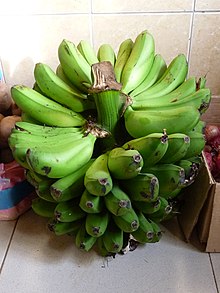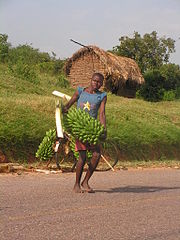Matoke,locally also known asmatooke,amatookein Buganda (Central Uganda),ekitookyein southwesternUganda,ekitookein westernUganda,kamatoreinLugisu(Eastern Uganda),ebitookein northwesternTanzania,igitokiinRwanda,Burundiand by the cultivar nameEast African Highland banana,are a group ofstarchytriploidbananacultivars, originating from theAfrican Great Lakes.The fruit is harvested green, carefully peeled, and then cooked and often mashed or pounded into a meal. In Uganda and Rwanda, the fruit is steam-cooked, and the mashed meal is considered a national dish in both countries.[2]
| East African Highland bananas | |
|---|---|
 A bunch of East African Highland bananas | |
| Species | Musa acuminata |
| Cultivar group | Musa acuminata(AAA-EA) or the Mutika/Lujugira subgroup of theAAA group[1] |
| Origin | Uganda |
| Cultivar group members | Seetext |


Matoke bananas are a staplefood cropinUganda,Kenya,Tanzania[3]and other Great Lakes countries. They are also known as the Mutika/Lujugira subgroup.
The medium-sized green fruits, which are of a specific group of banana, the East African Highland bananas (MusaAAA-EA),[4][5][6]are known in theBantu languagesofUgandaand WesternKenyaasmatoke.
Cooking bananas have long been and still are a common staple crop around theLake Victoriaarea of Kenya and Uganda, and in the West and Kilimanjaro regions of Tanzania.[7]
Description
editIn Uganda, East African Highland bananas are easily distinguishable from other banana cultivars by the numerous black (or more rarely brown or bronze) blotches on theirpseudostems,giving them the appearance of polished metal. The outermost sheath of their pseudostems is a medium green, superimposed over the pink to purple underlying sheaths.[8]
Their leaves are also darker green and dull, a difference more apparent when comparing them side by side with other banana cultivars from a distance.[8]
Theinflorescencehaspedunclescovered with coarse hair. Thebractsare ovate to lanceolate in shape with outer surfaces that are purple to brown and inner surfaces which are red fading to yellow towards the base. The male flowers have cream coloredtepalswith yellow lobes. Theanthersare pink, while thestigmataare orange.[8]
The fruits are recurved and can vary in length. They are inflated with blunt tips. The pulp is white in unripe fruits and cream-colored in ripe fruits.[8]
Taxonomy
editEast African Highland bananas are triploid (AAA) cultivars. Their official designation isMusa acuminataColla(AAA-EA).SynonymsincludeMusa brieyiDe Wild.Their paternal parent is theblood bananasubspecies(M. acuminatassp.zebrina) of the wild bananaspeciesMusa acuminata.[1]
East African Highland bananas are a subgroup that refers to about 200 individual banana cultivars (or clones).[1]They can be subdivided into five distinct groups of clones known as clone sets:
- Mbiddeorbeer clone set
- TheMbiddeclone set contains 14 cultivars.Mbiddemeans 'beer', and clones belonging to this clone set are usually used for makingbanana beer.[9]Their pulp is bitter and astringent with sticky brown excretions.[8]
- Nakitembeclone set
- Nakabululuclone set
- Nakabululuclones are soft-textured and savory. They mature quickly, but their fruits are smaller and have lesser overall yields per bunch.[10]
- Musakalaclone set
- Musakalaclones are characterized by slender fruits with bottle-necked tips. Other characteristics are the same as the preceding three clone sets.[8]
- Nfuukaclone set
- Nfuuka clones are characterized by inflated, rounded, or almost rectangular fruits with intermediate-shaped tips. The bunch shape is mainly rectangular. Other characteristics are the same as the other clone sets.[8]It is the most diverse of the five clone sets, a probable result of its tendency tomutatemore frequently. They bear heavy compacted bunches and are thus more often exploited commercially than other clone sets.[10]
Over 500 local names are known for cultivars from the EAHB subgroup.[11]
Origin and distribution
editEast African Highland bananas were introduced early intoAfricafromSoutheast Asiaduring the first to sixth centuries AD, probably via trade.[11]They are genetically distinct from the other AAA cultivars, having evolved locally in the African Great Lakes region for over a millennium. They are found nowhere else in the world, and the African Great Lakes has been called the secondary center of banana diversity because of this (with Southeast Asia being the first). East African Highland bananas are considered to be especially diverse inUganda,Burundi,andRwanda.[1][9]However, genetic analysis has revealed that all East African Highland bananas are genetically uniform, having most likely originated from a single ancestral clone (introduced to Africa within the past 2000 years) that underwent population expansion by vegetative propagation.[12]The triploid East African Highland banana gene pool arose from a single hybridization event, which generated a genetic bottleneck during the foundation of the crop genepool. Triploid East African Highland bananas are sterile, and have been asexually vegetatively propagated for generations by successive generations of farmers since their introduction to Africa. This has likely led to the emergence of the genetically near-isogenic somatic mutants (i.e. today's East African Highland banana varieties) that have been selected by farmers and environments across East Africa.[13]
Economic importance
editEast African Highland bananas are one of the most important staple food crops in the African Great Lakes region, particularly for Uganda,Tanzania,Kenya, Burundi, and Rwanda.Per capitaannual consumption of bananas in Uganda is the highest in the world at 0.70 kg (1.5 lb) daily per person.[14]Including Rwanda and Burundi, consumption is about 250 to 400 kg (550 to 880 lb) per person annually (about three to 11 bananas each day).[15]Uganda is the second-largest producer of bananas in the world. It is, however, one of the smallest exporters, with the crops being used mostly for domestic consumption.[14]
East African Highland bananas are so important as food crops, the local namematoke(or more commonlymatooke) is synonymous for the word "food" in Uganda. Also, a portion of the East African Highland bananas locally known asmbiddeis used to produce juice and beer.[16][17]
Food preparation
editMatokeare peeled using a knife, wrapped in the plant's leaves (or plastic bags), and set in a cooking pot (Swahili:sufuria) atop the banana stalks. The pot is then placed on acharcoalor wood fire and thematokeis steamed for a couple of hours; water is poured into the bottom of the cooking pot multiple times. The stalks in the bottom of the pot keep the leaf-wrapped fruits above the level of the hot water. While uncooked, thematokeis white and fairly hard; cooking turns it soft and yellow. Thematokeis then mashed while still wrapped in the leaves or bags and often served on a fresh banana leaf. It is typically eaten with a sauce made of vegetables, groundpeanut,or some type of meat (goatorbeef).[citation needed]
Matokeare also used to make a popular breakfast dish calledkatogoinUganda.[18]Katogois commonly cooked as a combination of peeled bananas andpeanutsorbeef,though offal or goat meat are also common.[19]
InBukoba,Tanzania,matoke(orebitooke) are cooked with meat or smokedcatfish,and beans orgroundnuts.This method eliminates the need for preparing a separate sauce. In this recipe, thematokeare not mashed. Until the early 1980s, this was the most common meal in Bukoba and would be eaten all year.[citation needed]
See also
editReferences
edit- ^abcdRandy C. Ploetz; Angela Kay Kepler; Jeff Daniells; Scot C. Nelson (2007)."Banana and plantain — an overview with emphasis on the Pacific island cultivars"(PDF).Species Profiles for Pacific Island Agroforestry.Traditional Tree Initiative.RetrievedJune 5,2011.
- ^Tufariello, Maria; Mita, Giovanni; Bleve, Gianluca (2016-10-26), "Biotechnology can Improve a Traditional Product as Table Olives",Products from Olive Tree,InTech,doi:10.5772/64687,ISBN978-953-51-2724-6
- ^"Tanzania Statistical Abstract".nbs.go.tz.Retrieved2017-03-28.
- ^Karamura, D. and Mgenzi, B. 2004. On-farm conservation ofMusadiversity in the Great Lakes region of East Africa. African Crop Science Journal 12(1):75-83.
- ^Karamura, D., Mgenzi, B., Karamura, E. and Sharrock, S. 2004. Exploiting indigenous knowledge for the management and maintenance ofMusabiodiversity on-farm. African Crop Science Journal 12(1).
- ^Mgenzi, S.R.B., Mshaghuley, I.M., Staver, C. and Nkuba, J.M. 2005. A study on the analysis ofMusaprocessing businesses and their support environment in Tanzania. A paper presented to theMusaprocessing businesses and their support environment workshop, Manila, Philippines 10-13 Oct. 2005. INIBAP [online], accessed 2011 June 14 from:"Archived copy"(PDF).Archived fromthe original(PDF)on 2011-08-24.Retrieved2011-06-14.
{{cite web}}:CS1 maint: archived copy as title (link). - ^Raschke, V., Oltersdorf, U., Elmadfa, I., Wahlqvist, M.L., Cheema, B.S.B. and Kouris-Blazos, A. 2007. Content of a novel online collection of traditional east African food habits (1930s – 1960s): data collected by the Max-Planck-Nutrition Research Unit, Bumbuli, Tanzania. Asia Pac. J. Clin. Nutr. 16(1):140-151 [online]. Accessed 2011 June 14 from:http://apjcn.nhri.org.tw/server/APJCN/Volume16/vol16.1/Finished/Raschke.pdf.
- ^abcdefgDeborah Karamura; Barbara Pickersgill (1999)."A classification of the clones of East African Highland bananas (Musa) found in Uganda "(PDF).Plant Genetic Resources Newsletter(119). Bioversity International & Food and Agriculture Organization: 1–6. Archived fromthe original(PDF)on March 20, 2012.RetrievedJune 16,2011.
- ^abA.K. Tugume; G.W. Lubega; P.R. Rubaihayo (2002)."Genetic diversity of East African Highland bananas"(PDF).Infomusa.11(2). Bioversity International: 28–32. Archived fromthe original(PDF)on August 12, 2011.RetrievedJune 16,2011.
- ^abG. Nantale; E.K. Kakudidi; D.A. Karamura; E. Karamura; G. Soka (2008)."Scientific basis for Banana Cultivar Proportions on-farm in East Africa".African Crop Science Journal.16(1). African Crop Science Society: 41–49.ISSN1021-9730.RetrievedJune 16,2011.
- ^ab"Banana cultivar checklist on ProMusa".Retrieved28 May2014.
- ^Kitavi, Mercy; Downing, Tim; Lorenzen, Jim; Karamura, Deborah; Onyango, Margaret; Nyine, Moses; Ferguson, Morag; Spillane, Charles (2016-01-08). "The triploid East African Highland Banana (EAHB) genepool is genetically uniform arising from a single ancestral clone that underwent population expansion by vegetative propagation".Theoretical and Applied Genetics.129(3): 547–61.doi:10.1007/s00122-015-2647-1.ISSN1432-2242.PMID26743524.S2CID6144293.
- ^Kitavi M, Downing T, Lorenzen J, Karamura D, Onyango M, Nyine M, Ferguson M, Spillane C. The triploid East African Highland Banana (EAHB) genepool is genetically uniform arising from a single ancestral clone that underwent population expansion by vegetative propagation. Theoretical and applied genetics. 2016 Mar 1;129(3):547-61.
- ^abRobert Kalyebara; Jackson M. Nkuba; Mgenzi Said Ramadhan Byabachwezi; Enoch Mutebi Kikulwe; Svetlana Edmeades (2003). "Overview of the Banana Economy in the Lake Victoria Regions of Uganda and Tanzania". In Melinda Smale; Wilberforce K. Tushemereirwe (eds.).An Economic Assessment of Banana Genetic Improvement and Innovation in the Lake Victoria Region of Uganda and Tanzania(PDF).International Food Policy Research Institute. pp. 25–36.RetrievedJuly 12,2011.
- ^Lois Englberger; Ian Darnton-Hill; Terry Coyne; Maureen H. Fitzgerald; Geoffrey C. Marks (2003)."Carotenoid-rich bananas: A potential food source for alleviating vitamin A deficiency"(PDF).Food and Nutrition Bulletin.24(4). The United Nations University: 303–318.doi:10.1177/156482650302400401.PMID14870618.S2CID6726153.Archived fromthe original(PDF)on July 26, 2011.RetrievedJuly 12,2011.
- ^R. Birabwa; P.J.A. van Asten; I.N. Alou; G. Taulya (2010)."Got Matooke (Musaspp.) for Christmas? "(PDF).Acta Hort.(879): 113–122.doi:10.17660/actahortic.2010.879.9.Archived fromthe original(PDF)on March 10, 2014.RetrievedJuly 12,2011.
- ^Linda Nordling (October 1, 2010)."Uganda prepares to plant transgenic bananas".Nature.doi:10.1038/news.2010.509.RetrievedJuly 12,2011.
- ^"The king of all breakfast".Daily Monitor.April 1, 2012.Retrieved19 February2014.
- ^"Katogo".Archived fromthe originalon 29 January 2015.Retrieved19 February2014.